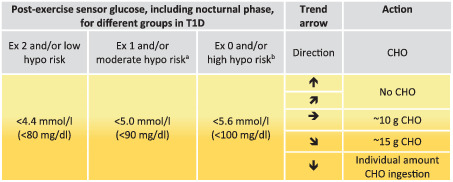TABLE 3.
Sensor glucose targets for carbohydrate consumption during the post‐exercise phase, including the nocturnal post‐exercise phase if exercise was performed in the late afternoon/evening

|
Note: Sensor glucose thresholds for treatments are detailed for the following groups in type 1 diabetes(T1D): intensively exercising and/or low risk of hypoglycaemia (Ex 2); moderately exercising and/or moderate risk of hypoglycaemia (Ex 1); minimally exercising and/or high risk of hypoglycaemia (Ex 0).
If an insulin correction is applied due to high sensor glucose levels, then the regular correction factor might be reduced by up to 50%.
Check sensor glucose at least 30 min after carbohydrate consumption and repeat treatment if required.
These recommendations are not applicable to hybrid closed‐loop systems.
The intensity of yellow shading indicates the level of action required: lighter yellow shading indicates that minimal/moderate action is required, while darker yellow shading indicates that moderate/intense action is required.
CHO, carbohydrate; Ex, exercise; hypo, hypoglycaemia.
Recommendation for older adults with coexisting chronic illnesses and intact cognitive and functional status.
Recommendation for older adults with coexisting chronic illnesses or two or more instrumental ADL impairments or mild‐to‐moderate cognitive impairment.
